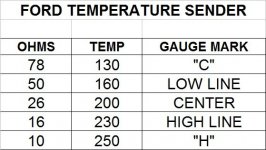I have a inline 200 engine. The block is a 1966. The head is a large log 1969. I have installed a water temp sencer for the 69 head. The them gauge on my dash reports close to max line in a very short time and stays there. The cluser is a 65 setup. Now when I install a Spencer for a 65/66 block. Temp stays in mid range. The engine shows no sign of over heating. All new pump and rad. So what am I asking. Does anyone know if the ohm on a 65/66 censer is different from a 69 censer. Fyi. The 65 is a lot small in o.d. so I had to adapt it to fit
All Small Six Temp sensor
- Thread starter ScottGibs
- Start date

